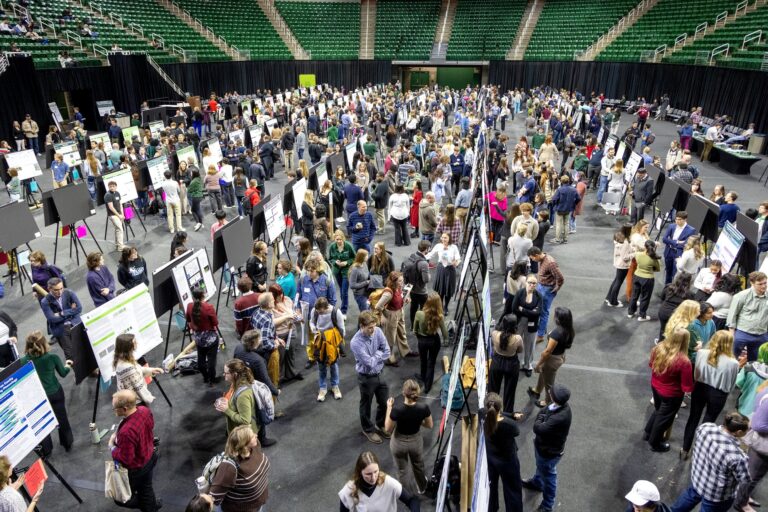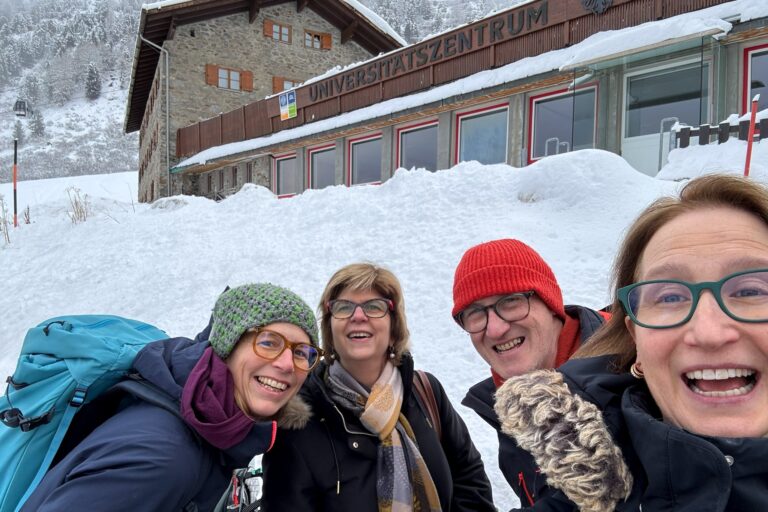In recognition of her outstanding scholarly achievements and their transformational impact, Aline Godfroid, Professor of TESOL (Teaching English to Speakers of Other Languages) and Second Language Studies in the Department of Linguistics, Languages, and Cultures at Michigan State University, was named a Red Cedar Distinguished Professor, which is among MSU’s highest faculty awards. Godfroid is the first College of Arts & Letters faculty member to receive this prestigious honor.
An internationally recognized scholar of applied linguistics and second language studies, Godfroid is the leading expert on the use of eye tracking in applied linguistics and co-director of MSU’s Second Language Studies Eye-Tracking Lab as well as a leader in the advancement of innovative research methodologies in language learning.

“Professor Godfroid has brought prominence to the Applied Linguistics program, and we are able to attract outstanding graduate students because of her, and those students consistently go on to be leaders in the field,” Yen-Hwei Lin, Professor and Chair of the Department of Linguistics, Languages, and Cultures, wrote in her nomination letter. “Professor Godfroid is collegial, always willing to volunteer, supportive of her colleagues and her colleagues’ students, and she always has insightful and well-delivered communications in faculty and staff meetings. She adds to Michigan State University tremendously in all matters of academic life: teaching, research, and service, and beyond. She represents the best of the Spartans.”
The Red Cedar Distinguished Professorship was established by Michigan State University in 2022 to honor individuals with exemplary, externally recognized scholarly accomplishments that align with MSU’s strategic research priorities. It also reflects a commitment to teaching excellence and innovation.
“Professor Godfroid has brought prominence to the Applied Linguistics program, and we are able to attract outstanding graduate students because of her…She represents the best of the Spartans.”
Yen-Hwei Lin, Professor and Chair of the Department of Linguistics, Languages, and Cultures
Godfroid is among the nine MSU faculty members who were named Red Cedar Distinguished Professors in 2025. Currently there are only 20 Red Cedar Distinguished Professors at MSU.
“It’s a wonderful recognition that is very meaningful to me and to my family,” Godfroid said. “It is also a reflection of the really good working conditions in which I’ve been able to do my research and to build the Eye-Tracking Lab. I’m humbled and honored, and grateful that it acknowledges the collaborative work that we do with students, in research, and with visiting scholars.”
Godfroid joined MSU in Spring 2011 shortly after completing her doctoral studies at the University of Brussels (Vrije Universiteit Brussel) in Belgium and has become a driving force in the field of Second Language Studies, particularly in cognitive approaches to language learning and the application of eye-tracking technologies that explore how individuals process and learn language.

Her book, “Eye Tracking in Second Language Acquisition and Bilingualism: A Research Synthesis and Methodological Guide” (Routledge, 2020), has become the definitive source on eye-tracking for social scientists researching the psychological, linguistic, and social properties of language acquisition and was a finalist for the American Association for Applied Linguistics First Book Award.
In addition to this single-authored book, Godfroid has published two edited books, 31 refereed journal articles, and 10 refereed book chapters. She also is an associate editor of “Language Learning,” one of the top two journals in second language acquisition.
“Dr. Godfroid’s intellectual leadership is demonstrated first by the consistent high number and quality of publications in multiple top-tiered journals as well as the tremendous breadth and impact of this scholarship,” Lin wrote.
“Dr. Godfroid’s intellectual leadership is demonstrated first by the consistent high number and quality of publications in multiple top-tiered journals as well as the tremendous breadth and impact of this scholarship.”
Yen-Hwei Lin, Professor and Chair of the Department of Linguistics, Languages, and Cultures
Godfroid has won two of the most prestigious awards in the field of applied linguistics: Best of The Modern Language Journal Research Article Award for “Should we listen or read? Modality effects in implicit and explicit knowledge,” published with her graduate student mentee Kathy MinHye Kim in 2019. She also won the TESOL Award for Distinguished Research from the professional organization TESOL International for the study “Incidental vocabulary learning in a natural reading context: An eye-tracking study,” published in “Bilingualism: Language and Cognition” in 2018.
At the heart of Godfroid’s work is the Second Language Studies Eye-Tracking Lab, among the earliest dedicated labs of its kind in applied linguistics. Through high-speed video tracking of eye movements, Godfroid and her colleagues can infer how learning happens in real time —where learners focus their attention, where they encounter difficulty, and how instruction can be tailored to individual learner profiles.

“Eye tracking provides a window into the mind,” Godfroid said. “It tells you what someone is paying attention to, what they are likely to learn, and where they may struggle. It’s a remarkably versatile tool based on a powerful idea: there’s a link between the eye and the mind. You can watch the process of learning unfold before your eyes as people are engaging with instructional materials.”
Godfroid’s work has helped mainstream this methodology within second language acquisition research. In addition to co-directing the lab, she teaches a graduate-level course on eye-tracking — one of the few offered in North America — and hosts visiting scholars and doctoral students from around the world. Her research and mentorship have been supported by multiple external grants, including three doctoral dissertation improvement grants from the National Science Foundation and the Language Learning Research Club.
“I’m really proud of our graduates and the people who have come through the lab and then gone on to take on various positions, sometimes faculty positions at other institutions where they have started their own labs,” Godfroid said.
“Eye tracking provides a window into the mind. It tells you what someone is paying attention to, what they are likely to learn, and where they may struggle. It’s a remarkably versatile tool based on a powerful idea: there’s a link between the eye and the mind.”
Dr. Aline Godfroid
The Red CedarDistinguished Professorship is intended to enhance the stature of MSU’s intellectual work to national and global prominence. Faculty awardees retain the title of Red Cedar Distinguished Professor for the duration of their service to MSU. Besides the title, honorees receive supplemental scholarly funding for the first three years of receiving this award, which is jointly funded by the Provost, the Vice President for Research and Innovation, and the nominating college.
Looking ahead, Godfroid plans to use the support from the Red Cedar Professorship to pursue new lines of inquiry that integrate computational linguistics with psycholinguistic data. By pairing large-scale analyses of language complexity with eye-tracking data, she hopes to create more individualized insights into learner engagement and difficulty.
“I want to bring psycholinguistic and computational methods together so that we can make instruction more interactive, responsive, and personalized,” she said. “This approach has the potential to scale up from individual learners to larger populations, helping us understand not only where people struggle, but also how instruction can be adapted in real time.”

Godfroid also is exploring ways to expand access to eye-tracking methods beyond the research-intensive university setting. She envisions offering workshops and training opportunities for practitioners in industry or education who are eager to adopt the technique but lack institutional infrastructure.
“There’s a lot of people who are excited about the technique and want to learn about the technique but aren’t at a large research university like Michigan State,” Godfroid said. “I want to lower the barriers to entry, so the technology becomes more accessible to more people. I think that would be really exciting.”
“One thing I’ve always appreciated about this institution is that there are no invisible barriers or boundaries. There’s always been a growth mindset and a can-do mentality, and I’ve really appreciated that.”
Dr. Aline Godfroid
Reflecting on her time at MSU, Godfroid emphasized the institutional culture that has supported her growth.
“I’m very thankful to MSU, which has supported me from right after graduate school,” she said. “One thing I’ve always appreciated about this institution is that there are no invisible barriers or boundaries. There’s always been a growth mindset and a can-do mentality, and I’ve really appreciated that. The collaborative spirit here has made it possible to build projects and labs that go beyond what any one researcher could do alone, and as I look ahead, I want to pay that forward by creating the same kind of supportive environment for the students and scholars I work with.”
Godfroid will be recognized during the 2025 MSU State of the University and Investiture for Endowed Faculty event on Tuesday, Sept. 30, at the Wharton Center for Performing Arts as the university honors all the newest Endowed Chairs, Endowed Professors, MSU Foundation Professors, and Red Cedar Professors.
By Austin Curtis and Kim Popiolek


